Review of J/36
Basic specs..
The hull is made of fibreglass. Generally, a hull made of fibreglass requires only a minimum of maintenance during the sailing season.
The J/36 is equipped with a fin keel. A boat with a fin keel is more manoeuvrable but has less directional stability than a similar boat with a full keel.
The keel is made of lead. Compared with iron, lead has the advantage of being 44% heavier, which allows a smaller keel and hence less water resistance and higher speed.
The boat can only enter major marinas as the draft is about 2.01 - 2.11 meter (6.59 - 6.89 ft) dependent on the load. See immersion rate below.
The boat is typically equipped with an inboard Yanmar diesel engine

Sailing characteristics
This section covers widely used rules of thumb to describe the sailing characteristics. Please note that even though the calculations are correct, the interpretation of the results might not be valid for extreme boats.
What is Theoretical Maximum Hull Speed?
The theoretical maximal speed of a displacement boat of this length is 7.4 knots. The term "Theoretical Maximum Hull Speed" is widely used even though a boat can sail faster. The term shall be interpreted as above the theoretical speed a great additional power is necessary for a small gain in speed.
The immersion rate is defined as the weight required to sink the boat a certain level. The immersion rate for J/36 is about 224 kg/cm, alternatively 1256 lbs/inch. Meaning: if you load 224 kg cargo on the boat then it will sink 1 cm. Alternatively, if you load 1256 lbs cargo on the boat it will sink 1 inch.
Sailing statistics
This section is statistical comparison with similar boats of the same category. The basis of the following statistical computations is our unique database with more than 26,000 different boat types and 350,000 data points.
What is L/B (Length Beam Ratio)?
Maintenance
When buying anti-fouling bottom paint, it's nice to know how much to buy. The surface of the wet bottom is about 39m 2 (419 ft 2 ). Based on this, your favourite maritime shop can tell you the quantity you need.
Are your sails worn out? You might find your next sail here: Sails for Sale
If you need to renew parts of your running rig and is not quite sure of the dimensions, you may find the estimates computed below useful.
| Usage | Length | Diameter | ||
| Mainsail halyard | 37.1 m | (121.8 feet) | 12 mm | (1/2 inch) |
| Jib/genoa halyard | 37.1 m | (121.8 feet) | 12 mm | (1/2 inch) |
| Spinnaker halyard | 37.1 m | (121.8 feet) | 12 mm | (1/2 inch) |
| Jib sheet | 11.0 m | (36.0 feet) | 14 mm | (0.55 inch) |
| Genoa sheet | 11.0 m | (36.0 feet) | 14 mm | (0.55 inch) |
| Mainsheet | 27.4 m | (90.0 feet) | 14 mm | (0.55 inch) |
| Spinnaker sheet | 24.1 m | (79.2 feet) | 14 mm | (0.55 inch) |
| Cunningham | 4.6 m | (15.0 feet) | 12 mm | (1/2 inch) |
| Kickingstrap | 9.1 m | (30.0 feet) | 12 mm | (1/2 inch) |
| Clew-outhaul | 9.1 m | (30.0 feet) | 12 mm | (1/2 inch) |
This section is reserved boat owner's modifications, improvements, etc. Here you might find (or contribute with) inspiration for your boat.
Do you have changes/improvements you would like to share? Upload a photo and describe what you have done.
We are always looking for new photos. If you can contribute with photos for J/36 it would be a great help.
If you have any comments to the review, improvement suggestions, or the like, feel free to contact us . Criticism helps us to improve.

- Forums New posts Unanswered threads Register Top Posts Email
- What's new New posts New Posts (legacy) Latest activity New media
- Media New media New comments
- Boat Info Downloads Weekly Quiz Topic FAQ 10000boatnames.com
- Classifieds Sell Your Boat Used Gear for Sale
- Parts General Marine Parts Hunter Beneteau Catalina MacGregor Oday
- Help Terms of Use Monday Mail Subscribe Monday Mail Unsubscribe
J36 BALSA CORED HULL ?
- Thread starter Gill
- Start date Jan 7, 2007
- Forums for All Owners
- Ask All Sailors
I am thinking of purchasing a "81 J36 with some water intrusion around the rudder post into the balsa core. I believe the area to be 3' in diameter max. The area compromised is above the waterline and I think I can cut out the inner liner, recore the affected areas and lay up the liner. Anyone have any experience with this or any ideas?
- This site uses cookies to help personalise content, tailor your experience and to keep you logged in if you register. By continuing to use this site, you are consenting to our use of cookies. Accept Learn more…
The J36 is a 35.95ft fractional sloop designed by Johnstone and built in fiberglass by J Boats between 1981 and 1984.
55 units have been built..
The J36 is a light sailboat which is a very high performer. It is very stable / stiff and has a low righting capability if capsized. It is best suited as a racing boat. The fuel capacity is originally small. There is a very short water supply range.
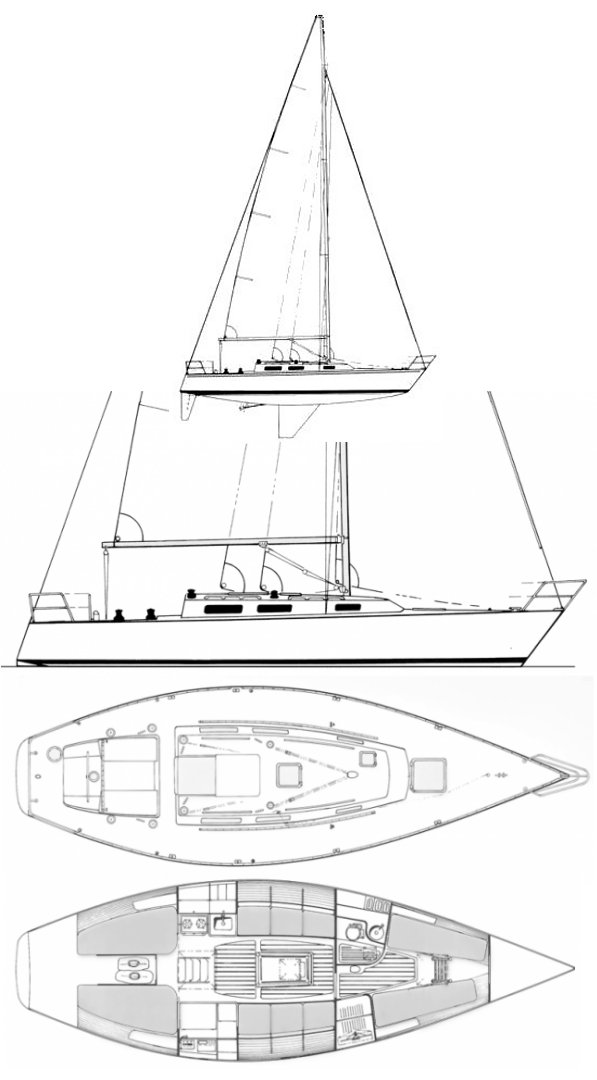
J36 for sale elsewhere on the web:

Main features
| Model | J36 | ||
| Length | 35.95 ft | ||
| Beam | 11.76 ft | ||
| Draft | 6.60 ft | ||
| Country | United states (North America) | ||
| Estimated price | $ 0 | ?? |
Login or register to personnalize this screen.
You will be able to pin external links of your choice.

See how Sailboatlab works in video
| Sail area / displ. | 22.07 | ||
| Ballast / displ. | 43.52 % | ||
| Displ. / length | 166.31 | ||
| Comfort ratio | 19.08 | ||
| Capsize | 2.15 |
| Hull type | Monohull fin keel with spade rudder | ||
| Construction | Fiberglass | ||
| Waterline length | 30.50 ft | ||
| Maximum draft | 6.60 ft | ||
| Displacement | 10570 lbs | ||
| Ballast | 4600 lbs | ||
| Hull speed | 7.40 knots |

We help you build your own hydraulic steering system - Lecomble & Schmitt
| Rigging | Fractional Sloop | ||
| Sail area (100%) | 662 sq.ft | ||
| Air draft | 0 ft | ?? | |
| Sail area fore | 309.47 sq.ft | ||
| Sail area main | 352.50 sq.ft | ||
| I | 44.21 ft | ||
| J | 14 ft | ||
| P | 47 ft | ||
| E | 15 ft |
| Nb engines | 1 | ||
| Total power | 18 HP | ||
| Fuel capacity | 20 gals |
Accommodations
| Water capacity | 30 gals | ||
| Headroom | 0 ft | ||
| Nb of cabins | 0 | ||
| Nb of berths | 0 | ||
| Nb heads | 0 |
Builder data
| Builder | J Boats | ||
| Designer | Johnstone | ||
| First built | 1981 | ||
| Last built | 1984 | ||
| Number built | 55 |
Modal Title
The content of your modal.
Personalize your sailboat data sheet
- New Sailboats
- Sailboats 21-30ft
- Sailboats 31-35ft
- Sailboats 36-40ft
- Sailboats Over 40ft
- Sailboats Under 21feet
- used_sailboats
- Apps and Computer Programs
- Communications
- Fishfinders
- Handheld Electronics
- Plotters MFDS Rradar
- Wind, Speed & Depth Instruments
- Anchoring Mooring
- Running Rigging
- Sails Canvas
- Standing Rigging
- Diesel Engines
- Off Grid Energy
- Cleaning Waxing
- DIY Projects
- Repair, Tools & Materials
- Spare Parts
- Tools & Gadgets
- Cabin Comfort
- Ventilation
- Footwear Apparel
- Foul Weather Gear
- Mailport & PS Advisor
- Inside Practical Sailor Blog
- Activate My Web Access
- Reset Password
- Customer Service

- Free Newsletter

Ericson 41 Used Boat Review

Mason 33 Used Boat Review

Beneteau 311, Catalina 310 and Hunter 326 Used Boat Comparison

Maine Cat 41 Used Boat Review

Tips From A First “Sail” on the ICW

Tillerpilot Tips and Safety Cautions

Best Crimpers and Strippers for Fixing Marine Electrical Connectors

Thinking Through a Solar Power Installation

Getting the Most Out of Older Sails

How (Not) to Tie Your Boat to a Dock

Stopping Mainsheet Twist

Working with High-Tech Ropes

Fuel Lift Pump: Easy DIY Diesel Fuel System Diagnostic and Repair

Ensuring Safe Shorepower

Sinking? Check Your Stuffing Box

The Rain Catcher’s Guide

Boat Repairs for the Technically Illiterate

Boat Maintenance for the Technically Illiterate: Part 1

Whats the Best Way to Restore Clear Plastic Windows?

Mastering Precision Drilling: How to Use Drill Guides

Giving Bugs the Big Goodbye

Galley Gadgets for the Cruising Sailor

Those Extras you Don’t Need But Love to Have

UV Clothing: Is It Worth the Hype?

Preparing Yourself for Solo Sailing

How to Select Crew for a Passage or Delivery


Preparing A Boat to Sail Solo

On Watch: This 60-Year-Old Hinckley Pilot 35 is Also a Working…

On Watch: America’s Cup

On Watch: All Eyes on Europe Sail Racing

Dear Readers

Chafe Protection for Dock Lines
- Inside Practical Sailor
The Best Sailboats for the High Seas?
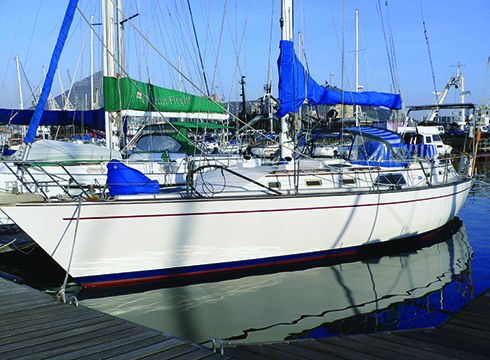
At the St. Petersburg Boat Show month last month, I had the pleasure of seeing delivery skipper and author John Kretschmers presentation on what he called sailboats for a serious ocean. I have reservations about any ideal boat list, but Kretschmer, who reviews boats for Sail Magazine and whose most recent book Sailing a Serious Ocean is available in our online bookstore , has the ideal background for this sort of work, and a list like this is undeniably helpful for wannabe cruisers who need a place to start their search.
I certainly wouldnt limit my search to boats on such a list, but by paying careful attention to the pros and cons of each, you can find something that suits your own aspirations.
Here are the boats Kretschmer suggests: Contessa 32, Pacific Seacraft 34, Pretorien 35, Cape Dory/Robinhood 36, Valiant/Esprit 37, Prout Snowgoose 37, Alajuela 38, Privelege 39, Freya 39, Passport 40, Caliber 40, Baba 40, Hallberg Rassy 42, Taswell 43, Hylas 44, Norseman 447, Beneteau 456, Outbound 44, Hylas 46, Kaufman 47, Tayana 48, Hylas 49, Amel Maramu 53, and the Sundeer 60/64. For a brief capsule summary of each, be sure to check out his website.
The list is hardly definitive. There are plenty of good boats that arent featured, and some of these would be ill-matched for the wrong sailor-Kretschmer clearly pointed this out during his talk. I like how the list presents a good cross-section of the various shapes and sizes for a boat in this category. For example, Kretschmer includes the Prout Snowgoose and Steve Dashews Sundeer 60, boats that, notwithstanding their successful record at sea, fill an outlying niche.
If I were going to expand the list, one of the heavier-displacement microcruisers like those I blogged about would be a nice addition. Although I would be wary of promoting even the most formidable of this breed as well-suited for a serious ocean, John Neale of Mahina Tiare Expeditions includes one of them, the Dana 24, on his own list of recommend cruising boats . Neales much broader list of boats is accompanied by a very helpful discussion of design elements to consider.
What got me thinking about formidable cruising boats was our series of reports o n sailboat construction , focusing specifically on structural details. Although there are plenty of excellent coastal cruisers on the market, once you start talking about offshore duty, scan’tlings (the dimensions for structural components) take on far more importance.
A few years ago we touched on this subject in our Mailport section, encouraging readers to suggest their own nominees for a list of what we called at the time, tough boats, vessels that were built to take a beating, requiring minimal care and upkeep.
Here are some of the boats that were suggested from our readers: Mariner 36, Cal 34, Morgan 43, Swan 43, Bermuda 40, Island Packet 26, Mariner 47, LeComte Northeast 38, Westsail 32, Dana 24, J/35, and the CSY 44.
Id be interested in hearing of other nominees for this list, or other good resources for sailors looking for a short list of good offshore boats.
For those who are frustrated to find that their own ideal boat isn’t on anybodys list, I wouldnt be too miffed. The best line Ive heard in a while on this topic came from Steve Callahan, the author of the survival classic Adrift , who gave a presentation at the Port Townsend Wooden Boat Show . When I asked Steve, who has sailed extensively on both multihulls and monohulls, what type of boat he preferred, he said, quite seriously. Well, at the end of the day, the best cruising boat is the one that you are on.
RELATED ARTICLES MORE FROM AUTHOR
On watch: this 60-year-old hinckley pilot 35 is also a working girl.
Interesting list. I am fond of Hylas of which you chose three models. However, I am suspect of their yard and construction techniques and do not have confidence that they are as strong as they are beautiful. Only one Hallberg-Rassy was selected, which is a far more robust and dry sailing boat than the Hylas. Passports make a good boat as does Cape Dory and several others on your list. Didn’t four sailors die on a Beneteau in 2018? Over all it is a decent list.
https://metro.co.uk/2018/04/25/last-pictures-doomed-yacht-cheeki-rafiki-sank-killing-four-british-sailors-7497805/
I believe this is the accident you’re talking about in which a Beneteau and it’s bolted on keel parted company.
Almost all of the sailing clubs in San Diego rent Beneteaus out. They are a decent coastal sailboat. I have a couple friends who have even made the crossing to Maui in them..not me, not ever. I consider them a living room boat. Having said that, I am certainly no expert so its just my opinion. If I am crossing an ocean I want a capable kindly strong boat with redundancy built into critical systems.
Curious to think what people think about the early 70s Swan 43 as a cruising boat for a couple with occasional guests for a round the world trip? I have an S&S 30 which is too small but I do have some bias towards their designs. Add a watermaker and some power generation and off you go… Any thoughts?
Are Motor Sailors like the Nauticats or Fishers ocean worthy ( if their pilot house windows and sliding doors are lifeboatified ? )
Walt Schulz’s Shannon 43 is a beautiful, sea kindly, comfortable and sturdy bluewater boat. Walt had not only the ICW and Bahamas in mind when he designed and built 52 of them. He designed for ocean cruising. He believes his boats should outlive him and still sailing for generations. We sailed the Chesapeake, Bahamas, Caribbean and Pacific to Australia on a Shannon 43 ketch. She took great care of us and is still turning heads.
Great article! John Kretchmer is one of my fave modern day sailors. While there is only one Crealock design on John’s list, and the Dana is added on John Neale’s list, I was surprised not to see a Crealock/ Pacific Seacraft 37 mentioned. But there are so many great serious off shore boats, it’s hard to narrow it down to 10. Here’s a few to think about. Cape George Cutter 36. Biscay 36, tradewind 35, Rustler 36, Nicholson 31 (never talked about) and 32. Seldom seen on top 10 lists, but great boats. Thanks for the article.
Great comment and interesting to note that the first four of your additions are those currently entered in the 2022 Golden Globe Race – kind of the definition of a blue water boat.
Hey! I know this is somewhat off-topic however I needed to ask. Does operating a well-established blog like yours take a massive amount work? I am completely new to writing a blog but I do write in my journal everyday. I’d like to start a blog so I will be able to share my experience and feelings online. Please let me know if you have any kind of recommendations or tips for new aspiring blog owners. Thankyou!|
LEAVE A REPLY Cancel reply
Log in to leave a comment
Latest Videos

What’s the Best Sailboats for Beginners?

Why Does A Sailboat Keel Fall Off?

The Perfect Family Sailboat! Hunter 27-2 – Boat Review

Pettit EZ-Poxy – How to Paint a Boat
Latest sailboat review.
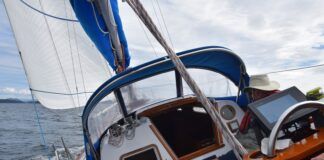
- Privacy Policy
- Do Not Sell My Personal Information
- Online Account Activation
- Privacy Manager

First impressions Johnstone has always had an uncanny ability to design incredibly fast boats that manage to sail well across the spectrum and also maintain a handsome bearing on the water. Many of today's fast boats are almost garish in appearance with their plumb bows and abrupt hull shapes designed for downwind flying. It's as if they are craving attention, like a teenager's tattoos, declaring, "Look at me I'm fast." I suspect in 10 or 15 years, these boats will look completely outdated, replaced by the latest and greatest ideas for generating boat speed. Johnstone's boats on the other hand look like boats, not platforms designed to skid across the water faster than the next platform. And as we all know, most sailing is upwind, an area in which his boats often excel. The J/29 is able to carry a full main in 15-plus knots, making 6.5 knots of boat speed. The 29 began life as a modified J/30 and the rakish lines are quite similar. On the 29, however, Johnstone lowered the freeboard, redesigned the keel and trimmed the weight. Although it has 4 inches less LOA and the same 11-foot beam, the 29 weighs 1,000 pounds less and has almost as much sail area. Naturally, the 29's vertical center of gravity is lower than the 30's. And although most 29s were built with fractional rigs, a masthead rig was an option. Simplicity was hard-wired into the boat: From an outboard motor for auxiliary power, to the outboard rudder, to a lack of runners on the fractional rig, the J/29 has always been a boat that you can jump aboard and sail because not a lot of set-up is required. The boat sails well under main alone, and even with a moderately size genoa, the loads are rarely excessive. It is an easy boat to sail well.
Construction The J/29 was never intended to be a ULDB, at least in comparison to West Coast boats, and the construction reflects this philosophy. The similarly sized Olson 30, for example, displaces just 4,000 pounds, while the J/29 tips the scales at 6,000 pounds. Within the framework of being a performance boat, the build is actually rather robust. The hull and deck are balsa cored and joined on a typical inner flange, incorporating the teak toerail where applicable. Tillotson-Pearson, which has since pioneered the SCRIMP manufacturing process, has always done good glass work, and the 29 has some interesting beefed-up specifications. The main bulkhead, a well documented problem in the J/24, and the keel floors are actually culled from the same scantlings as the J/36. A large fiberglass molding is used as a floor and furniture pan, which helps stiffen the hull and originally streamlined the manufacturing process. The high-aspect outboard rudder is attached to the transom with stainless steel pintles and gudgeons. Most of the deck hardware is through-bolted and accessible, an important feature on a boat where the fittings may need to be replaced and updated due to regular racing wear and tear.
What to look for The J/29 has held up extremely well over the years, considering that most of the boats have been sailed hard and often put away wet. Of course, since many 29s are almost 20 years old all age-related problems should be thoroughly inspected before making a decision to buy. Don't overpay for an impressive but old sail wardrobe. In fact, you should consider new sails a given when buying a J/29 because nothing breathes life into this racer like new sails. This is where the boat's simplicity makes it appealing. The rudder pintles and gudgeons are a bit on the light side, and should be replaced if they look at all suspicious, although on the 1983 model I climbed through in Fort Lauderdale, Florida, they were clearly original and in good condition. If the gudgeons have been leaking, be sure to check the transom for delamination since some water may have penetrated the core. Several of the deck fittings on the boat I looked at were cracked, including the aluminum cleats. The hatch cover was also cracked, apparently from being stood on, and the teak handrails were loose. These are all areas that should be carefully examined since deck fitting problems often metamorphose into deck delamination problems. A bit of stomping around revealed some degree of delamination around the sheet winches and in the cockpit. Inside the boat, the molded liner was cracked in several places, obviously from the hull being tweaked now and then. The tabbing on the other hand, at least where I could see, was in good shape. The chainplates also leaked and had soiled the main bulkhead. J Boats had its share of blisters, and some have suggested that the constant fairing of its hulls by owners contributed to the problem by skimming away at the gelcoat. This seems rather unlikely since blisters begin in the laminate. But even so, it is a good idea to find out if and when an epoxy bottom repair job was done.
On deck Because of the J/29's racing pedigree, the deck is well-designed for ease of handling, but the cockpit is not especially comfortable since you actually sit on the aft deck more than in the cockpit, which can be wet to say the least. The mainsheet traveler spans the cockpit and is easily controlled from the tiller. The sheet winches are forward of the traveler, making it a bit awkward for a singlehander, but the boat is ideal for a couple when not racing. The tiller head is stainless steel and the tiller itself is oak and robust. Dual compasses are often set into the coachroof bulkhead, and there is room for instrument displays as well. Double lifelines were standard. The stanchions bases are backed and well-supported, but are often the source of leaks. The pulpits are a bit undersized, and the original nonskid is likely to be worn nearly smooth. Naturally, the headsail tracks are close inboard, and all boats will be set up with spinnaker gear since the 29 predates J Boat's introduction of the retractable sprit. The mast and boom were built by Sparcraft in 4060 aluminum sections. The fractional rig has an air draft of 47 feet, 6 inches while the masthead rig is 4 feet shorter.
Down below The interior of the J/29 is spartan but functional. Low freeboard and a sleek, low-slung coachroof results in a distinct lack of headroom-about 5 feet, 4 inches. The layout includes two quarter berths aft and two settees in the main cabin, perfect for a racing crew. The forward locker may be a sail locker, or it may have been converted into a double berth. Some boats were fitted with manual heads, although most will have porta potties. At least the boat complies with EPA regulations. The galley originally consisted of an Igloo cooler and a sink. There is actually a fair bit of teak below, including veneers on the main bulkhead, a teak-and-holly sole and teak companionway steps. I imagine that when refinished the boat can look rather smart.
Engine Although an inboard diesel was an option, J Boats emphasized outboard motors when marketing the boat, again stressing the simplicity theme. As a result most boats have outboards, which are really very practical. Mounted on a transom bracket, a relatively small and light engine pushes the boat at 6 knots. It is also easily removed or stored below for racing. Another advantage of an outboard is that when it is broken you can pop it into the trunk and take it home or drop it off at the shop.
Under way This is what it's all about with a J/29. The boat is fast on all points of sail and truly excels upwind. By all accounts, with the rig tuned the boat can carry a full main and No. 1 genoa in 15 knots true while making 6.5 knots and staying on her feet. The J/29 sails better under mainsail alone than other comparably sized cruiser/racers do with a main and headsail. Trimming up the main generally requires keeping the top battens parallel to the boom, unless it is extremely light, and then the leach must be opened to prevent stalling. In heavy going, the sail needs to be flattened with the backstay and the mainsheet eased to reduce weather helm and excessive heel. Typically headsails are changed before the main is reefed, and the boat is quite stiff in 25 knots with a No. 3 and full main. Reefing the main is reserved for gales. According to the J/29 class association, it is common to fly a No. 1 genoa in up to 20 knots apparent before dropping to the No. 2. The boat handles beautifully under spinnaker, sustaining surfing runs in double digits without undue stress. This point can't be overemphasized; the J/29 is a very controllable, well-built boat that can sail at exhilarating speeds without the accompanying heart palpitations.
Conclusion The J/29 represents an excellent value if you're looking for solid performance but can't bear the thought of new boat prices. With a proud pedigree, good company support, an active one-design class, and prices hovering on either side of $20,000, the J/29 is hard to beat.
Also in Used Boat Notebook
- Hunter Passage 42
- Pearson Rhodes 41
- Santa Cruz 52
- Allied Princess 36
- Kelly-Peterson 46
Also from John Kretschmer
- Hove to in the gales of Biscay
- Sailing's Promise
- Passage to nowhere
- Farewell to brothers of the sea
- Plotting a course to Caribbean sabbatical cruise
- Passage Planning
- Ready to Rumble
- Good vibrations
- Launching and boarding a life raft
- The Great Circle Route: Connecting the dots of a sailing life
- BOAT OF THE YEAR
- Newsletters
- Sailboat Reviews
- Boating Safety
- Sails and Rigging
- Maintenance
- Sailing Totem
- Sailor & Galley
- Living Aboard
- Destinations
- Gear & Electronics
- Charter Resources
- Ultimate Boat Giveaway

- By Herb McCormick
- Updated: July 31, 2002
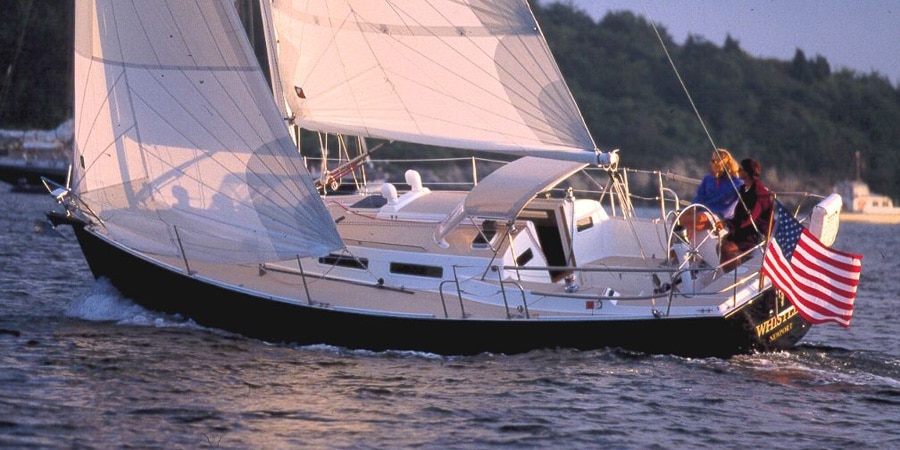
For any sailor, it’s always fun checking out a new J/Boat. The reason is simple — they’re a joy to sail. Sure, depending on the model, the crusty cruiser may yearn for more teak and displacement, and the fickle racer might be more swayed by this week’s hot one-design. But anyone who gets a jolt out of hoisting a sail, sheeting it in and grabbing the helm will find something to like in just about any J.
Still, it was with more than the usual sense of anticipation that I stepped aboard the cruising oriented J/32. I’ve spent good chunks of the last two years living aboard a 1975 C&C 33 with, give or take an inch or two, the same length overall — in my case 32’6″. I like the way my boat sails. My wife and I are quite comfortable aboard, and obviously it has become the focal point of our on-the-water experience. So I was anxious to compare the difference two decades had made in “state-of-the-art” production boats of similar size and — because we use our boat strictly for cruising — purpose.
The J/32 is the first design from young Alan Johnstone, the son of founding J/Boat designer Rod Johnstone. Alan says he got many of the ideas for the 32-footer after a cruise with his wife aboard a 40-foot J/120, a sporty racer/cruiser with an emphasis on performance. One of his big goals was to make an all-around boat even easier than that one for a couple to sail.
From the helmsman’s station alongside the big 48-inch Edson wheel and pedestal, everything (Lewmar two-speed self-tailing winches, Sailtec hydraulic backstay adjuster, Harken traveler and 6:1 mainsheet system — with coarse and fine trim!) is a simple twist or turn away. Moving forward, the efficiency theme continues. The cockpit seems plucked from a much larger boat; another set of Lewmar self-tailers and “Superlock” clutches is stationed on the coach roof for halyards and reefing lines. Lazy jacks, a Hall Quik-Vang on the boom and a Schaefer 1100 headsail furling system are all standard.
The difference between the circa ’70s rig and the J/32 approach is vast (as are the sailing characteristics). Gone are the days of high-aspect rigs with short booms and wimpy mainsails. The J/32 employs a low aspect, double-spreader fractional rig stationed fairly well forward, making for a relatively small foretriangle and easily managed headsails. The mainsail is big and roachy, and unlike my boat’s it provides plenty of drive without a jib. Once the headsail is unfurled, however, the J/32 really comes into her own. Our test boat, equipped with a 140 percent genoa, easily topped 6 knots close-hauled in 11 knots of true breeze.
For off-the-wind work, an optional spinnaker hardware package includes all the gear necessary to fly a cruising chute tacked to the stemhead fitting and to set and douse it using a spinnaker sock. No poles, guys or fuss — and again, an easy 6-plus-knots in moderate air on a beam to broad reach.
Like the cockpit, the belowdecks layout appears startlingly roomy. Freed from the overhang constraints of the old IOR rule, the J/32 employs a waterline length of 28’8″ — a full 2 1/2 feet longer than my once beloved antique. Add another six inches of beam, to 11 feet, and standing headroom for a six-plus-footer, and suddenly it’s apparent that the greater interior volume is not an illusion.
The accommodation plan is laid out for a couple, and the space has been used wisely. The forward cabin features a 6’6″ V-berth, with a good-size hanging locker. In the central saloon, the opposing 6’4″ settees make good sea berths. The starboard settee slides open to make a second double. The head, with wet locker, and a standing nav table are to port; an L-shaped galley, with two-burner Force 10 propane stove and six-cubic-foot icebox is to starboard. There is no aft cabin. Instead, the designer has opted for a dedicated, walk-in storage locker aft of the galley. It’s a sensational idea for a two-person layout, and extremely rare on a production vessel of this size.
The J/32 is built to a high standard by TPI Composites utilizing the SCRIMP resin infusion technique over a balsa core. It comes with a 10-year hull warranty against blistering. Though it’s a boat that would probably be classified as a coastal cruiser because of its LOA, nonetheless with oversize chain plates, a surprising 10,000 pounds of displacement and a deep, six-foot-draft bulb keel (a 4’8″ shoal-draft version is also available), it definitely has offshore capabilities. In fact during last year’s Boat Of The Year testing, California-based judge Bill Lee said he’d love to sail one to Hawaii.
The boat is powered by a Yanmar 27-horsepower diesel turning a 16-inch Martec two-blade folding propeller. With a 27-gallon fuel tank, the builder says a cruising range of 300 miles can be expected. On our test run, the boat made an easy 6.3 knots at 2,000 rpms, and was responsive and maneuverable in forward and reverse.
Along with the options listed above, this versatile cruiser is also available with a shore power package, a “systems group” that includes a second 50-gallon water tank and cockpit shower, a windlass, a carbon fiber mast and a quarter berth in lieu of the storage area. Base price for the J/32 is $117,500; with a reasonably tricked-out version, expect to pay between $120,000 and $130,000.
As one who has often wandered the docks muttering that nothing new has occurred in the sailboat market in the last 20 years, I walked off the J/32 ready to eat my words, my hat, or whatever else was offered. Young couples or retired ones looking for a boat that’s a blast to sail and still full of creature comfort should put this one on their shopping lists.
#####J/32 Specifications
LOA: 32′ 5″ (9.88 m.) LWL: 29′ 0″ (8.84 m.) BEAM: 11′ 0″ (3.35 m.) DRAFT (deep): 6′ 0″ (1.83 m.) DRAFT (shoal: 4′ 9″ (1.45 m.) BALLAST: 3,850 lbs (1,746 kgs.) DSPL: 10,000 lbs. (4,536 kgs.) SA (100%): 518 sq.ft. (48.12 sq.m.) Mast above water: 48’6″ (14.8 m.) Ballast/Disp: .39 Disp/Length: 183 SA/Disp: 17.9 Fuel: 27 gal. (102 ltr.) Water: 50 gal. (189 ltr.) Holding: 29 gal. (110 ltr.) Auxiliary: Yanmar 3GM-30 27-hp diesel Cabin headroom: 6’3″ (1.9 m.) Designer: R. Alan Johnstone Base Price: $117,500
J/Boats Inc. 557 Thames St. Newport, RI 02840 Phone (401) 846-8410 Fax (401) 846-4723
- More: 2001 - 2010 , 31 - 40 ft , Bluewater Cruising , J/Boats , keelboat , monohull , racer / cruiser , Sailboat Reviews , Sailboats
- More Sailboats

Sailboat Preview: Elan GT6 Explorer

For Sale: 1984 Camper & Nicholsons 58

Alubat Updates OVNI Models

For Sale: Little Harbor 63 Ketch
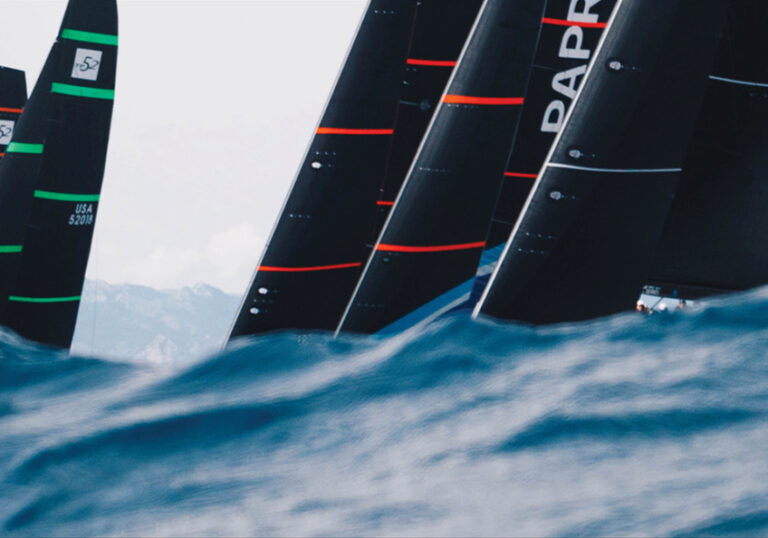
North Sails Parent Company Buys Doyle, Quantum
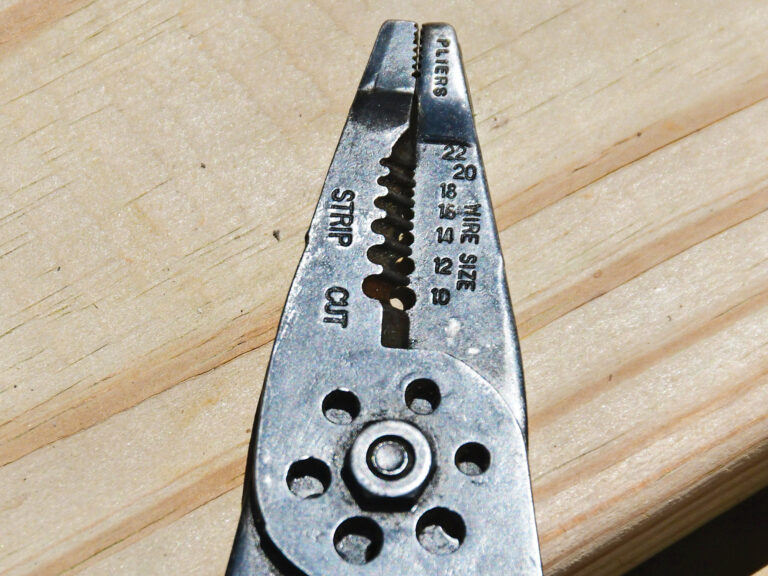
Top Tools for Sailboat Cruising: Must-Have Gear for 2024
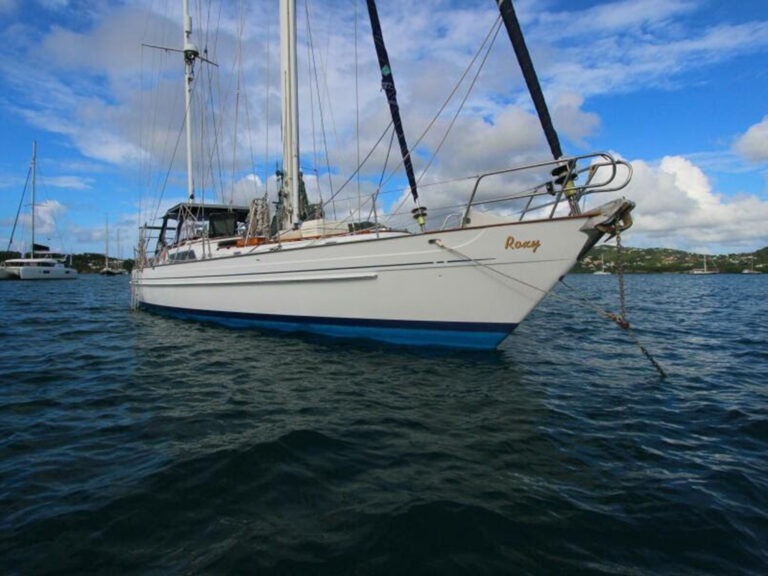
Sailing Avocet : A New Adventure Begins
- Digital Edition
- Customer Service
- Privacy Policy
- Terms of Use
- Email Newsletters
- Cruising World
- Sailing World
- Salt Water Sportsman
- Sport Fishing
- Wakeboarding




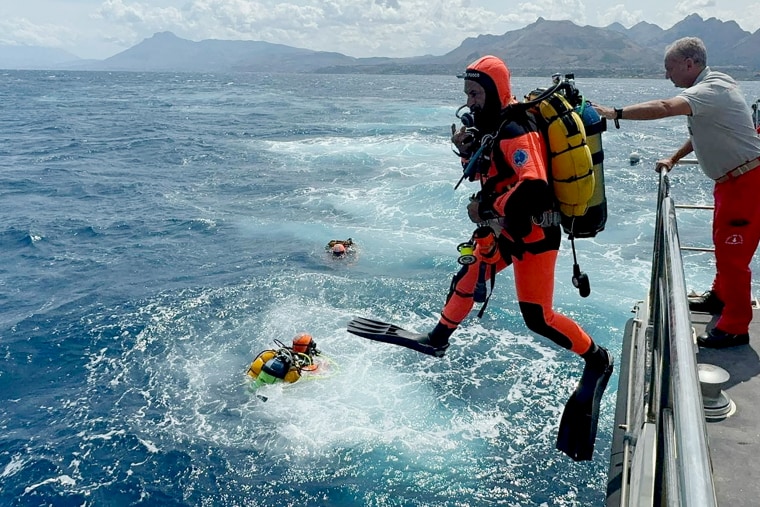
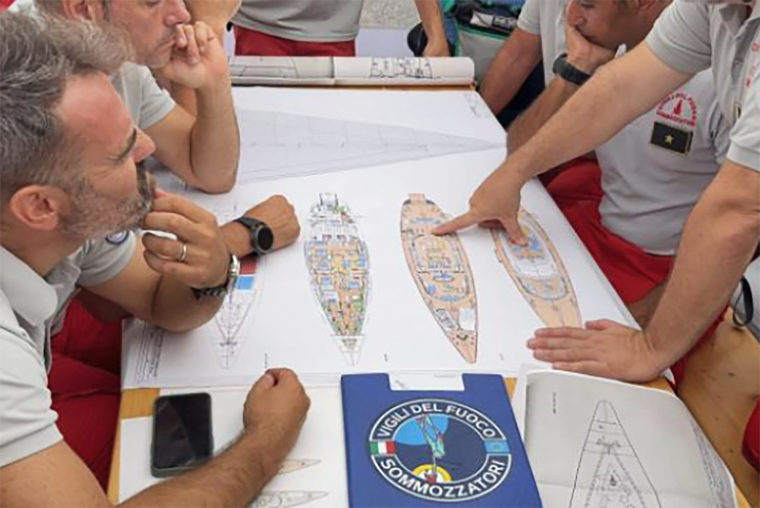

IMAGES
COMMENTS
outer sunset. May 5, 2006. #9. sam_crocker said: J/36 was the predecessor of the 35. The 36 is heavier with a bigger rig. Here in the PNW the 35 rates 72, the 36 rates 79. The 36 was a tough boat to beat in Vic-Maui races, although that might have been a rating thing.
The Performance Racer-Cruiser the Family Can Enjoy. The J/36 was originally conceived and designed to compete without regards to any handicap rule that was popular in the 1970's and 1980's. It's primary goal was to have a fast, fun, enjoyable boat to sail that the family could enjoy. Since then the J/36 has enjoyed success racing under the PHRF ...
The immersion rate is defined as the weight required to sink the boat a certain level. The immersion rate for J/36 is about 224 kg/cm, alternatively 1256 lbs/inch. Meaning: if you load 224 kg cargo on the boat then it will sink 1 cm. Alternatively, if you load 1256 lbs cargo on the boat it will sink 1 inch.
It takes into consideration "reported" sail area, displacement and length at waterline. The higher the number the faster speed prediction for the boat. A cat with a number 0.6 is likely to sail 6kts in 10kts wind, a cat with a number of 0.7 is likely to sail at 7kts in 10kts wind. KSP = (Lwl*SA÷D)^0.5*0.5
Boat Review Forum. SailNet is a forum community dedicated to Sailing enthusiasts. Come join the discussion about sailing, modifications, classifieds, troubleshooting, ... The J36 and later J35 stretched and refined this set of ideas even further. Next comes the narrow series, J-27 and J33, which were outand out racers compared to the J30 or J36
The lower a boat's ratio is, the less power it takes to drive the boat to its nominal hull speed or beyond. Read more. Formula. D/L = (D ÷ 2240) ÷ (0.01 x LWL)³ D: Displacement of the boat in pounds. LWL: Waterline length in feet; 166.1 <100: ultralight. 100-200: light. 200-300: moderate. 300-400: heavy
1 of 1. If you are a boat enthusiast looking to get more information on specs, built, make, etc. of different boats, then here is a complete review of J/36. Built by J Boats and designed by Rod Johnstone, the boat was first built in 1981. It has a hull type of Fin w/spade rudder and LOA is 10.96. Its sail area/displacement ratio 22.07.
G. Gill. Jan 7, 2007. #1. I am thinking of purchasing a "81 J36 with some water intrusion around the rudder post into the balsa core. I believe the area to be 3' in diameter max. The area compromised is above the waterline and I think I can cut out the inner liner, recore the affected areas and lay up the liner.
The J36 is a 35.95ft fractional sloop designed by Johnstone and built in fiberglass by J Boats between 1981 and 1984. 55 units have been built. The J36 is a light sailboat which is a very high performer. It is very stable / stiff and has a low righting capability if capsized. It is best suited as a racing boat. The fuel capacity is originally ...
J/36 Technical specifications & dimensions- including layouts, sailplan and hull profile.
1981-J36, Quest, located in Squalicum Harbor, Bellingham, WA. Newer 3GM Yanmar water cooled motor, professional racing bottom and foils (2018), rigging, turn buckles and solid wire stays (2017), full length mainsail track (2017), Ray Marine Instruments (2021), masthead wand (2021), bilge pump (2022). Sail inventory includes: Quantum main and #1 ...
Here are some of the boats that were suggested from our readers: Mariner 36, Cal 34, Morgan 43, Swan 43, Bermuda 40, Island Packet 26, Mariner 47, LeComte Northeast 38, Westsail 32, Dana 24, J/35, and the CSY 44. Id be interested in hearing of other nominees for this list, or other good resources for sailors looking for a short list of good ...
11.76'. 6.6'. Washington. $12,900. Description: With a PHRF 84 rating, the Johnstone design concept and Tillotson Pearson build of the J/36 is like J/Boats other successful racer/cruisers. Low freeboard and wide decks make this "J" a great cruising boat. The large mainsail invites comfortable, easy, powerful cruising under the mainsail alone.
J/29. September 2001One-design that's as good as new with an active racing fleet and Johnstone-designed style and speedThe J/29 is an enduring favorite in the usually fickle world of one-design racing. Boat speed has always been the mantra for one-design sailors, and today's boats have pushed this concept to another level.
The boat is powered by a Yanmar 27-horsepower diesel turning a 16-inch Martec two-blade folding propeller. With a 27-gallon fuel tank, the builder says a cruising range of 300 miles can be expected. On our test run, the boat made an easy 6.3 knots at 2,000 rpms, and was responsive and maneuverable in forward and reverse.
Texas. $39,000. Description: This is a J-36 racer cruiser in great condition. I have 12 diferent sails for her. 2 of them carbon fiber. I have 2 spiniker poles and one of them is carbon fiber. All the flares, life jackets and rigging. Only been in the water for a year with monthly hull cleaning. Fresh hull paint last year.
Seller's Description. With a PHRF 84 rating, the design concept of the J/36 is similar to J/Boat's other successful models (like the J/35) with low freeboard, wide decks for effective hiking and interior volume, a high aspect fractional rig, low wetted surface, and long effective sailing length. With a compact galley and enclosed head, the ...
For your chance to win the Airstream Interstate 24X and support a great cause, enter at: https://www.omaze.com/learningthelinesThis is the biggest 36 foot bo...
J/30 Used Boat Review. In the late seventies opportunity knocked at boat builders' doors. It was calling for an offshore one-design boat that would offer high performance at an affordable price. Most major manufacturers of the day heeded the call. C & C Yachts introduced the Mega 30. Tartan Marine offered the Tartan Ten.
The identity of those still missing emerged after an initial search of the 184-foot sailboat, named the Bayesian, was unsuccessful Monday. ... Divers review yacht blueprints during their search ...
Jeff_H. 12513 posts · Joined 2000. #2 · Jan 10, 2004. J-30''s are complicated to categorize. They, like the earlier J-24, were real pioneers in the evolution of yacht design. In their day they were about as fast as a 30 footer could get. Compared to other 30 foot race boats of that era they required pretty small crews and were very easy to ...